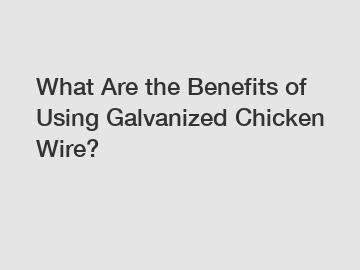How to choose welded reinforcing mesh for wildlife?
---.
Choosing the right welded reinforcing mesh for wildlife conservation projects can seem overwhelming due to the variety of available options. Various factors play a crucial role in ensuring that the mesh serves its intended purpose effectively without compromising the safety and well-being of wildlife. Here’s a guide to help you choose the best welded reinforcing mesh for wildlife.
#### Understand the Purpose.
Before diving into specifics, it’s essential to clarify the primary purpose of the welded mesh. Are you looking to create enclosures for catching and preserving wildlife, protecting specific habitats, or creating barriers to prevent road traffic accidents involving animals? Understanding the purpose will help you select the most suitable mesh type based on strength, flexibility, and visibility.
#### Material and Durability.
The material of the welded mesh significantly impacts its durability and effectiveness. Common materials include galvanized steel, stainless steel, and plastic. Galvanized steel is a popular choice due to its rust resistance and strength, making it suitable for long-term outdoor use. Stainless steel, while more expensive, offers superior corrosion resistance and is ideal for areas with high humidity or exposure to saltwater. Plastic meshes can be suitable for temporary installations but may not offer the same level of strength as metal options.
#### Wire Gauge.
The wire gauge is another critical factor to consider when selecting welded mesh. The wire gauge denotes the thickness of the wires used in constructing the mesh. A thicker wire gauge means a stronger mesh, which is crucial for resisting animal weight and pressure. For instance, if you're designing an enclosure for larger wildlife like deer, a thicker gauge will ensure the structural integrity of the mesh over time.
#### Mesh Size.
The size of the individual openings in the mesh is essential for wildlife safety. Larger openings may allow smaller animals to escape or could potentially injure wildlife. Conversely, smaller openings can prevent animals from getting entangled or trapped. It’s crucial to strike a balance between ensuring the mesh is strong enough to contain or protect wildlife while also allowing safe movement and visibility.
Additional resources:How Expanded Mesh Redefines Racking Solutions Today?
What factors influence perforated metal sun screen choices?
How Perforated Metal Heating Transforms Modern Design?
Derrick Shaker Screen Feedback: Performance vs. Durability Insights
Choosing the Right Slope Protection Wire Mesh: Key Factors
Maximize Durability with Top Metal Stretched Mesh Solutions
How Does Stainless Steel Trench Drain Price Compare?
#### Environmental Considerations.
When selecting welded reinforcing mesh for wildlife applications, it is imperative to consider environmental factors. Choose materials that can withstand the local climate conditions, including UV exposure, moisture levels, and temperature fluctuations. Some materials can degrade or become brittle when subjected to specific environmental factors, compromising the mesh's effectiveness over time.
#### Compliance and Regulations.
Different regions may have specific regulations and guidelines concerning wildlife conservation and related infrastructure. Ensure that you research and comply with local wildlife protection laws when selecting and installing welded mesh. This can save you from potential legal issues and ensure the necessary standards are upheld.
#### Consultation with Experts.
If you're uncertain about the specific requirements for your wildlife project, consider consulting with wildlife conservation experts or professionals who specialize in habitat protection. They can provide invaluable insights into selecting the right welded mesh and help you navigate any legal or environmental considerations.
#### Conclusion.
Choosing the right welded reinforcing mesh for wildlife involves evaluating the purpose, material, wire gauge, mesh size, environmental factors, and compliance with regulations. By considering these aspects, you can select a durable, safe, and effective welded mesh solution that protects wildlife while serving its intended function. Prioritizing the needs of the wildlife and their habitats not only promotes conservation efforts but also contributes to a sustainable coexistence with nature.
If you want to learn more, please visit our website Welded Reinforcing Mesh for Wildlife Sanctuaries, Welded Reinforcing Mesh for Sustainable Construction.
Additional resources:How Riveted Grating Shapes Urban Green Spaces?
Ultimate Guide to Galvanized Iron Wire Applications
Why Choose PVC Coated Gabion Wire Mesh?
What Are the Benefits of Stainless Steel Filters?
What factors influence Derrick Shaker Screen purchasing decisions?
What is a Slope Protection Net and Its Benefits?
Why Choose Stainless Steel Mesh Filters Over Plastic?









